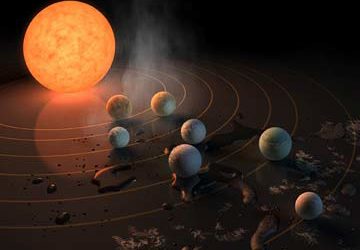
A newly built telescope facility in Morocco is a part of international observatories which recently discovered a unique solar system consist of the most amazing Earth sized planets, around an ultra-cool dwarf star.
The new system was discovered by ground and space based telescopes run by a team of international scientists from University of Liège in Belgium, Nasa and other similar facilities around the world.
The seven planets of the system revolve around a parent star known as TRAPPIST-1, named after TRAnsiting Planets and Planetesimals Small Telescope (TRAPPIST) facilities built by the University of Liège.
One observatory TRAPPIST-South is located in Chile whereas its twin facility TRAPPIST-North was inaugurated in Morocco last year.
The discovery first appeared in the journal Nature, saying the planetary zone could host the environment that could be suitable for water and alien life. This system has largest number of Earth-sized planets found so far.
If we want to look beyond our home for life, we must first locate stars like our sun and then earth like planets around it.
Seven wonders of the sky
Astronomers have found thousands of exoplanets but the TRAPPIST-1 is unique in many ways.
TRAPPIST-1 is a home of seven planets dubbed as TRAPPIST-1b, TRAPPIST-1c, d, e, f, g and h respectively.
Of these, TRAPPIST-1b, c and d are too hot due to their close distance from the parent star, while TRAPPIST-1h distance is unconfirmed.
But scientists are confident that TRAPPIST-1e, f and g are neither close nor far from the parent star and exist in most habitable zone.
With just 8 per cent the mass of the Sun, TRAPPIST-1 is very small in stellar terms and a little bigger than our Jupiter but a new research has unveiled its most disturbing aspect – the life threatening solar activity.
The violent solar flares
The discovery of TRAPPIST-1 made headlines across the world in February this year, but a team of scientists from Hungary has revealed its most disturbing aspect.
Scholars from Konkoly Observatory in Budapest have revealed that its solar flares are too frequent and strong enough to wreak havoc in the whole planetary system.
Using data from NASA’s Kepler mission, the team observed the TRAPPIST-1 light curve for more than 80 days. The researchers observed some 42 solar flare events which is equal to one chaotic event after every 48 hours.
The researchers fear that these solar flares could disturb the geomagnetic fabric of the planets in the system. The high energy radiation is also disastrous for the faint atmosphere of even the three planets (TRAPPIST-1e, f and g) lie in habitable area.
The importance of TRAPPIST-North
The TRAPPIST- North observatory was set in October last year in collaboration with Oukaimeden Observatory at Cadi Ayyad University in Morocco.
Speaking about the role of TRAPPIST-North the research associate at the Belgian Fund for Scientific Research (F.R.S.-FNRS), Michael Gillon said, “About 60% of its time is dedicated to the search for terrestrial planets transiting the nearest ultracool dwarf stars. We observed several transits of the TRAPPIST-1 planets, which brought a significant contribution to the results presented in recent paper published in weekly Nature.”
The Morocco observatory is also a good example of North-South co-operation. The Belgium-Morocco joint venture is playing a key role in capacity building of local astronomers.
“Professor Zuhair Benkhaldoun and Ahmed Dassaou are part of the Cadi Ayad team. Two students, Youssef Moulane (who works on comets) and Khalid Barkaoui (who works on exoplanets) have finished their PhD thesis in cotutelle with the University of Liege,” added Gillon.
Speaking to Muslim Science, Gillon said that we have requested to European institutes for further grant for the learning and skill development of Moroccan students through teaching and exchange program.
This is an ideal place for visual astronomy because of 250 cloudless days annually. The place is already a home for many telescopes from various universities and institutes around the world. It is also located at Atlas Mountains near the celestial equator which is best for sky hunting both from Northern and Southern hemispheres.